More than three decades after the installation of Kryptos, three of its four coded messages have been cracked — but one remains a mystery.

TwitterKryptos is a massive copper sculpture comprised of coded messages — but even once they’re deciphered, the sculpture’s true message will be locked behind more puzzles.
In a courtyard outside of the entrance to the Central Intelligence Agency’s New Headquarters Building, there is a mysterious sculpture dubbed “Kryptos.” Installed in 1990 by artist Jim Sanborn, Kryptos is a large, wave-shaped copper sculpture containing 1,800 characters that at first glance seem to be random, jumbled combinations
Random, however, these letters are anything but. Kryptos actually contains four distinct encrypted messages, three of which have been cracked over the course of the three decades since Kryptos was installed. The fourth has yet to be solved.
But even the sections of Kryptos’ message that have been cracked leave many wondering what the purpose of the sculpture is. In recent years, Sanborn has provided several clues as to what Kryptos’ fourth passage could mean, yet no one has been able to successfully solve this tantalizing puzzle.
Who Is Jim Sanborn, The Artist Behind Kryptos?
Herbert James Sanborn, better known as Jim Sanborn, was born in Washington, D.C. on Nov. 14, 1945. In 1969, he graduated from Randolph-Macon College with a double major in art history and sociology, later receiving his Master’s degree in sculpture from Pratt Institute in 1971.
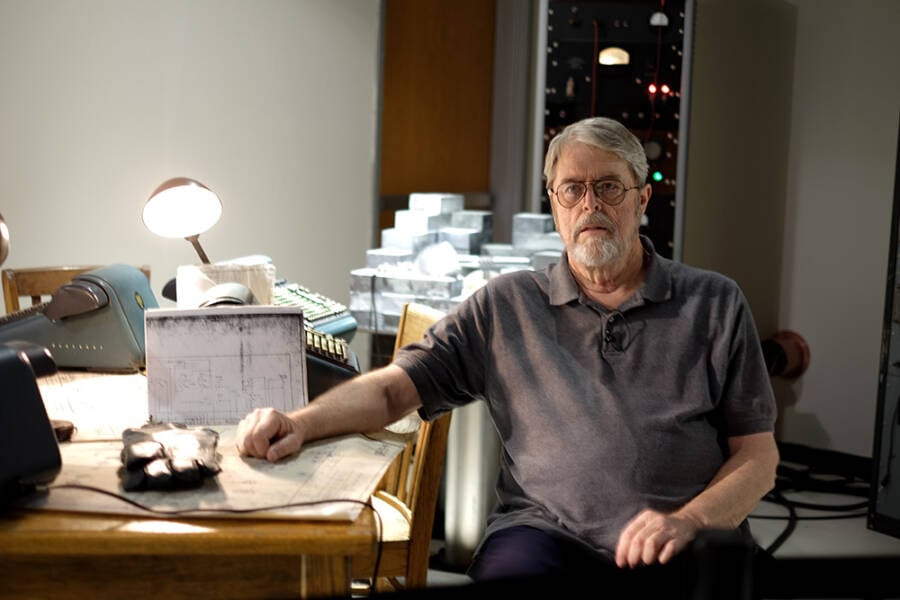
National Museum of Nuclear Science & HistoryArtist Jim Sanborn.
Sanborn’s works have been featured in a number of prominent and prestigious museums, including the High Museum of Art, the Los Angeles County Museum of Art, and the Corcoran Gallery of Art. Sanborn has also produced work for several institutions such as the Massachusetts Institute of Technology (MIT), the National Oceanic and Atmospheric Administration, and, most famously, the Central Intelligence Agency (CIA).
In 1990, Sanborn presented the CIA with a piece called “Kryptos” — a Greek word for “hidden.” And as its name would suggest, Kryptos’ meaning has remained hidden ever since.
The Puzzling Messages Hidden Within Kryptos
Jim Sanborn wrote the messages in Kryptos himself. These messages are obscured by a series of increasingly elaborate coded messages. At the time, only Sanborn and former CIA Director William H. Webster had the solution to the sculpture’s encrypted messages.
“Everyone wants to know what it says,” Sanborn told the Los Angeles Times in 1991. “They’re out there all the time. There are groups of dark-suited people pointing at it and getting down on their knees, trying to figure out what it says. Some take photographs. One guy copied the whole thing down with pencil and paper.”
Sanborn said at the time that a “friend of friend” told him CIA operatives had been growing frustrated with their inability to crack the code, even going so far as to send copies of the message to agents at the National Security Agency (NSA) to try and decipher it using the NSA’s Cray supercomputer.
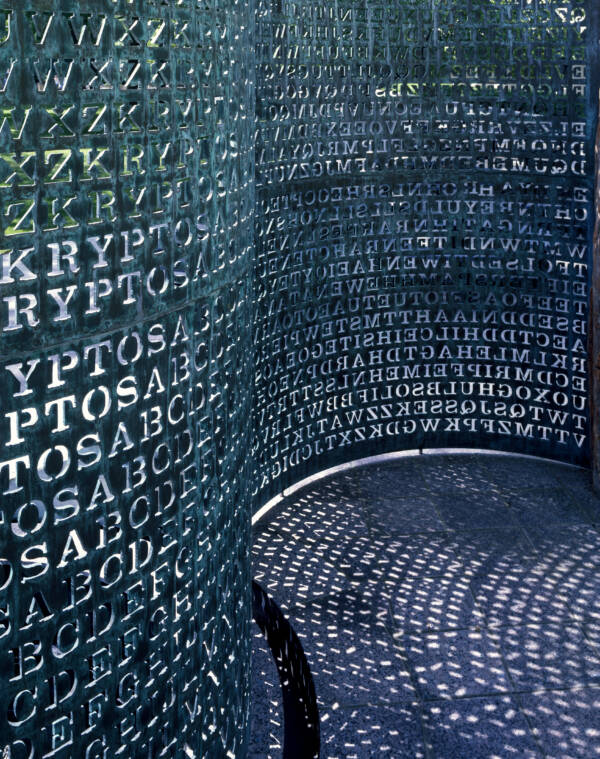
Carol M. Highsmith/Buyenlarge/Getty ImagesSanborn expected Kryptos’ fourth passage to be solved within a decade.
According to Sanborn, the sculpture’s message deals with the CIA tradition of secrecy on several levels. It includes a system of ciphers devised by the 16th-century French cryptographer Blaise de Vigenère, known as a Vigenère table, among other codes which Sanborn created with the help of retired CIA cryptographer Edward Scheidt.
“He developed something that really stumped them out there,” Sanborn said. “Parts can be deciphered in a matter of weeks or months, but other parts might never be deciphered without the knowledge that Webster has. He has the key to the code, and he can easily figure the whole thing.”
Of course, the difficulty of cracking the codes embedded in Kryptos have only added to the sculpture’s notoriety. And over the years since its introduction, significant chunks of the sculpture’s message have been cracked — though the fourth section’s translation has remained elusive.
Deciphering The Message Of Kryptos
It took about eight years for someone to come forward and say they had solved part of Kryptos’ message. In 1998, CIA physicist David Stein called a meeting to announce that he had solved the first three passages of the sculpture’s puzzling message.
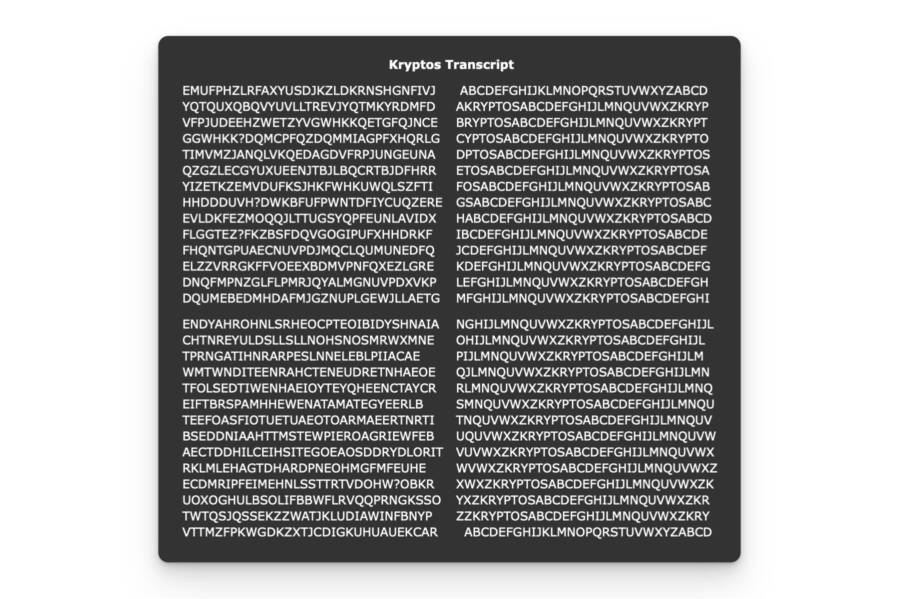
Karl Wang/University of California San DiegoA transcript of Kryptos’ message.
According to Smithsonian, around 250 people showed up to hear what Stein had found using just “pencil and paper alone.” Around the same time, a computer scientist named Jim Gillogly created computer programs to help crack the code, which is composed of classic ciphers, plus a few odd spelling errors and extra characters Sanborn intentionally left in to throw off codebreakers.
The first passage of Kryptos reads, “Between subtle shading and the absence of light lies the nuance of inqlusion.”
The second passage is a fair bit longer, reading in full:
It was totally invisible Hows that possible? They used the Earths magnetic field X
The information was gathered and transmitted undergruund to an unknown location X
Does Langley know about this? They should Its buried out there somewhere X
Who knows the exact location? Only WW This was his last message X
Thirty eight degrees fifty seven minutes six point five seconds north
Seventy seven degrees eight minutes forty four seconds west X
Layer two
“WW” in this passage is a direct reference to Webster. The third passage, also rather lengthy, includes another reference, this time to Egyptologist Howard Carter, the man who opened King Tutankhamen’s tomb.
It reads:
Slowly desparatly slowly the remains of passage debris that encumbered the lower part of the doorway was removed with trembling hands i made a tiny breach in the upper left hand corner and then widening the hole a little i inserted the candle and peered in the hot air escaping from the chamber caused the flame to flicker but presently details of the room within emerged from the mist X
Can you see anything q
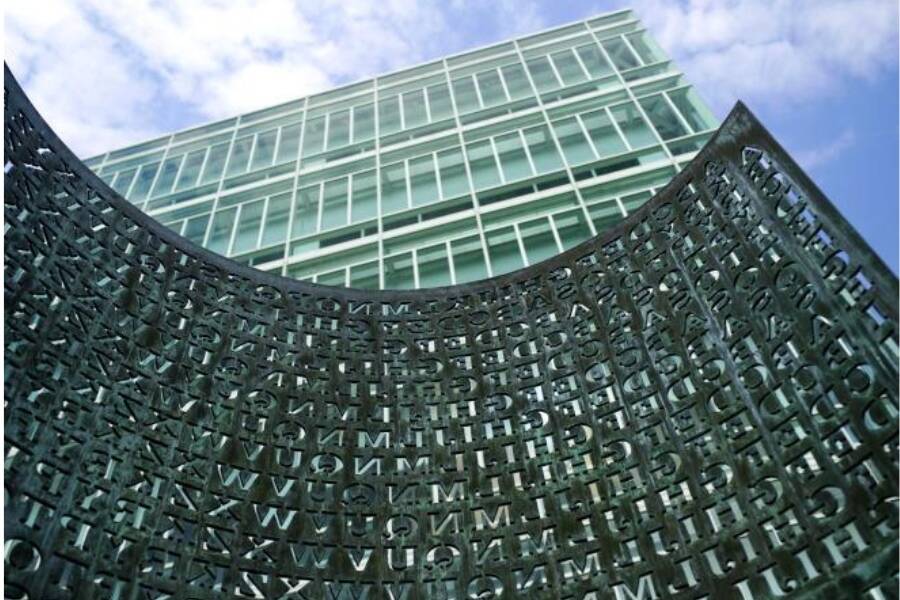
TwitterSanborn has provided three clues to help solve Kryptos’ fourth passage, in 2010, 2014, and 2020.
Sanborn has said that the mystery of Kryptos has lasted much longer than he originally expected. Initially, he assumed the first three passages would be solved in the matter of a few years, and the fourth, most difficult passage within a decade. But three decades on, the meaning of the fourth passage is still a mystery, and Sanborn, now in his mid-70s, has had to consider that the mystery may outlive him.
At one point, he even considered auctioning off the solution and donating the money to climate research. Then, in January 2020, Sanborn offered up another clue to try and help potential codebreakers solve the puzzle. He had done the same thing in 2010 and 2014, but the 2020 clue, he said, would be the last.
“NORTHEAST”: The Final Clue To Help Solve Kryptos
Surprisingly, the fourth section of Kryptos is actually the shortest one, coming in at just 97 characters. That hasn’t made it any easier to crack, however. In fact, its brevity “could, in itself, present a decryption challenge,” Edward Scheidt, the cryptographer who helped Sanborn devise the code, told The New York Times.
To further add to the difficulty of Kryptos’ fourth passage, the text in this section also uses what’s known as a masking technique, further obscuring the message. It’s not even entirely clear what masking technique Sanborn and Scheidt used.
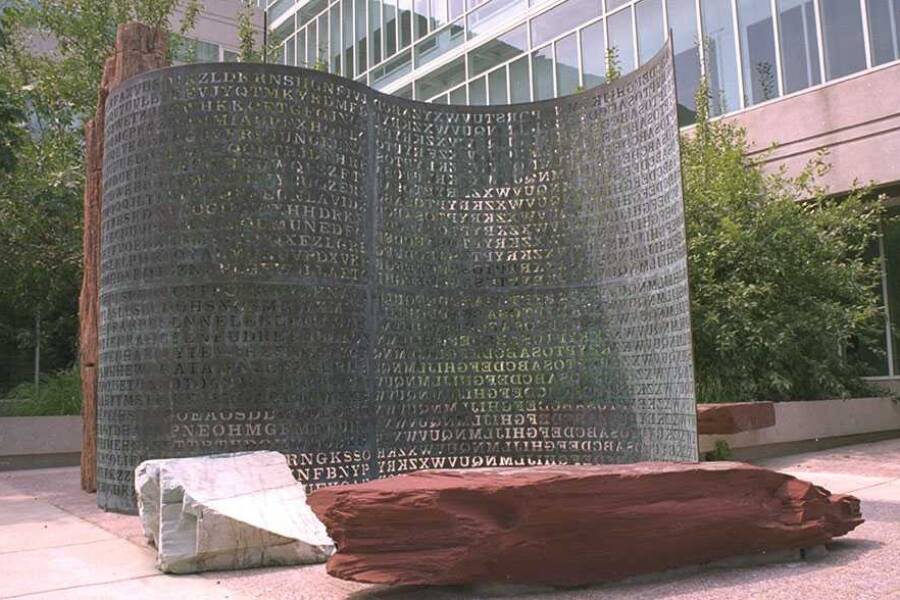
Wikimedia CommonsSeveral rocks and pieces of wood block the full text of Kryptos in photographs, making it more difficult to decipher.
Sanborn has received countless emails and letters over the years from prospective codebreakers, each hoping that they had finally solved the puzzle, but of course none of them had. As time went on, Sanborn decided to provide a few clues to guide would-be cryptographers.
The first clue came in 2010. It was a single word, “BERLIN,” which makes up the 64th through the 69th positions in the final passage. In 2014, Sanborn revealed the word “CLOCK” occupied spots 70 through 74.
The final clue, at positions 26 through 34, is “NORTHEAST.” In the now three years since Sanborn revealed the clue, the puzzle has still not been solved.
Even if it is, more puzzles await. As Sanborn explained, deciphering the code is only one part of the puzzle.
“They will be able to read what I wrote, but what I wrote is a mystery itself,” Sanborn said. “There are still things they have to discover once it’s deciphered. There are things in there they will never discover the true meaning of. People will always say, ‘What did he mean by that?’ What I wrote out were clues to a larger mystery.”